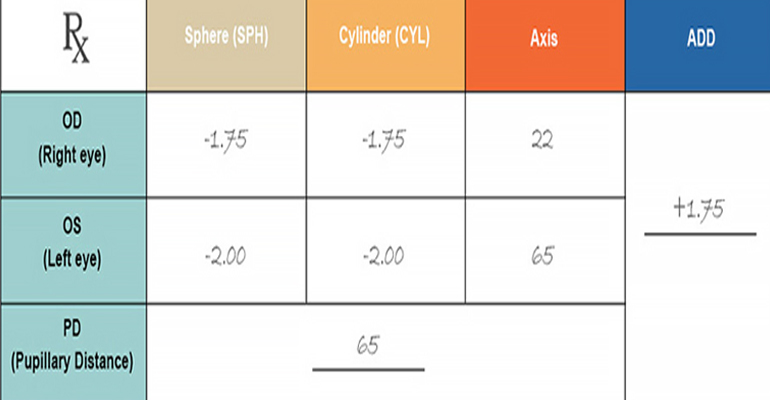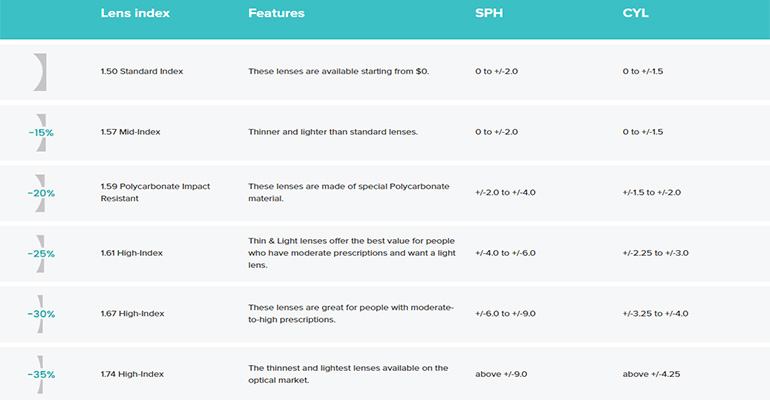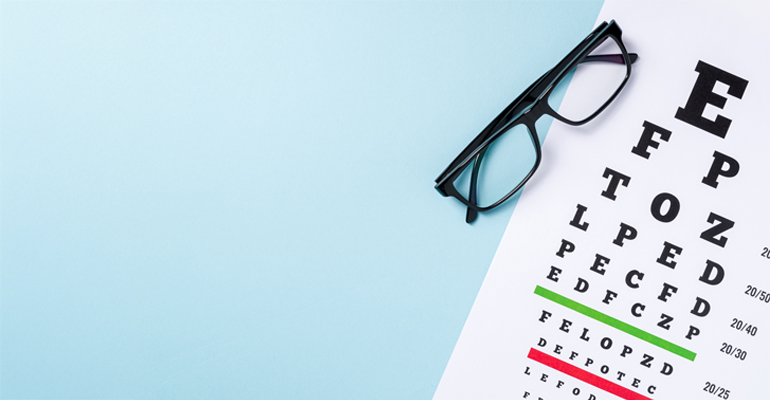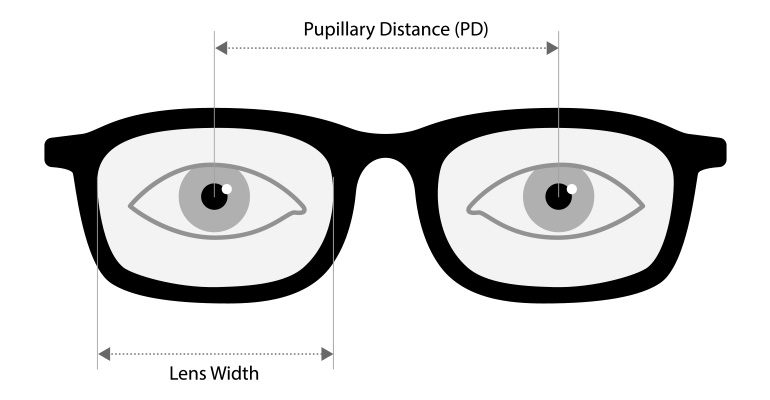How To Read My Prescription
Nov 28, 2024

If you’ve recently been to the opticians and been given an eye prescription for the first time, you're likely wondering what these numbers mean and how to read them.
Your unique prescription is given to you so it can correct your eyesight, it’s important you know your prescription so you can get the right glasses for your vision needs.
Our guide below will clear up any confusion about your eye prescription and take you through its key components so you can choose the right eyewear for your needs and understand your vision better.
What Is My Eye Prescription?
Your eyesight numbers in your new eye prescription are unique to correct your vision. You’ll often see a bunch of abbreviations, letters, and positive and negative numbers which show how far-sighted or near-sighted you are.
There are also special eye prescriptions for eyesight problems such as eye alignment problems and astigmatism.
In your eye prescription, you will see OD and OS, Sphere, Diopter, Cylinder, Axis, PD, and Prism correction depending on your vision needs.
OD and OS Understanding Your Eyes
Your prescription will have abbreviations for each of your eyes -
OD means oculus dexter and is your ‘right eye’ in Latin.
OS means oculus sinister and is your ‘left eye’ in Latin.
Sphere (SPH): Measuring Nearsightedness and Farsightedness
The sphere part of your prescription is the most important part for correcting your vision.
What Does SPH Stand For?
SPH stands for sphere or spherical power, this indicates the amount of lens strength/lens power needed to correct your nearsightedness (myopia) and farsightedness (hyperopia).
What Is Sphere In Eye Prescription?
This will be the - or + sign in your prescription. The minus sign (-) indicates nearsightedness while the plus sign (+) indicates farsightedness.

What Is a Diopter In Glasses?
Lens power is measured in a diopter. This is a unit of eyesight measurement abbreviated as ‘D’. This begs the question, is the sphere the same as power?
They are similar, except when we talk about power, we are including all components that go into lens strength such as cylinder and axis which we will move on to later.
For example, +1.5D means that you have farsightedness (hyperopia) with a 1.5 power. If you have a -2.5D prescription this means you have nearsightedness (myopia) with a 2.5 power.
What Is a 1.50 Glasses Prescription?
Having a -1.50 diopter prescription means that you have myopia which is also known as nearsightedness. If you are wondering how bad a -1.50 eye prescription is, it’s more common than you think and isn’t too bad compared to other lens powers, it’s classed as mild myopia.
Prescriptions can go as high as -6.00 and above for myopia which is considered high myopia and brings other vision complications.
What Is Prescription Strength?
The larger the number in your prescription strength then the stronger the prescription is to correct your vision.
At -0.25 degrees for example you can still do normal activities with this level of myopia without glasses.
If you have one of the lowest eye prescriptions of -0.50 you might be wondering if you need glasses with this prescription.
Well, nearsightedness of -0.50 can make people with myopia see a bit blurry but there are lots of people who can still see well at this level without the need for glasses.

Nearsighted Prescription Range
Nearsightedness is categorized into mild, moderate, high, and extreme -
Mild: -0.50 to -3.
Moderate: -3.25 to -5.00.
High: -5.25 to -10.00.
Farsighted Prescription Range
For farsighted AOA classifies it in this way -
Mild: +0.25 to +2.00.
Moderate: +2.25 to +5.00.
High: Greater than +5.00.
Diopters To 20/20
After going to the opticians for an eye test you will likely get the results as a fraction.
The top number of the fraction refers to the distance you are seated/standing away from the chart which is usually 20 feet.
The bottom number indicates the distance at which an average person with normal eyesight could read the same line that you read.
For example, 20/20 is considered normal vision, and 20/40 means that the line you read correctly could be read by a person with normal vision at 40 feet away. 20/200 is considered legally blind.
When you hear ‘diopters to 20/20’ this essentially means adjusting your eyeglass prescription to correct your vision so you can see clearly at 20 feet which means 20/20 vision.

Cylinder (CYL): Correcting Astigmatism
The cylinder value in your prescription is what addresses astigmatism which is a condition where blurry vision happens due to the shape of the eye. An eye is typically shaped like a basketball, it doesn’t matter which way you rotate it, the curve of the cornea stays the same. An eye with astigmatism is more oval-shaped.
The CYL of your prescription relates to how flat your eye is, the higher the number then the more astigmatism you have.
Just like the Sphere number, a minus sign will indicate near-sighted astigmatism while a plus sign indicates far-sighted astigmatism. If you have a “DS” in your eye prescription this means “Diopter Sphere” which means no cylindrical correction is needed for astigmatism.
Axis: Aligning Your Vision
The Axis in your prescription represents the orientation or angle of your astigmatism ranging from 1 to 180 degrees. The higher number does not correlate with the strength, it just means it is oriented differently.
For people with astigmatism, the Axis is extremely important since it specifies the orientation of your astigmatic correction making sure the cylinder is aligned correctly with your eye.
Add: Presbyopia Correction
The ‘add’ row in your prescription for glasses is meant for people with bifocal or progressives. It indicates the additional lens power or magnifying power needed for vision which is common in presbyopia.
The lowest prescription for reading glasses is +0.25 diopters, high strength prescriptions can go way past +2.50 diopters and up to +4.00 in some cases.
Glasses beyond +2.75 diopters may need to be custom-ordered.

PD: Pupillary Distance
This number is the distance from one center of the pupil to the other and is very important for lens customization. Learn more about your PD prescription here.
If you're wondering what OU means on your eye prescription, it means Oculus Uterque which is ‘both eyes’ in Latin.
Prism: Correcting Double Vision
Prism correction is used for vision alignment problems such as double vision, strabismus, crossed eyes, or lazy eye. It helps fuse two images so that only one is seen.
How To Read Prism Prescription
Prism - This relates to the amount of prismatic power, which is measured in prism diopters which is also typed as PD or a superscript triangle when written free hand. This is prescribed to help with eye alignment issues.
Base - This indicates where the thickest edge of the prism is split into base up (BU), base down (BD), base in (BI), and base out (BO).
GlassesShop: Your Premier Eyewear Destination
With over 1800 frames, GlassesShop offers a large variety of prescription eyeglasses and sunglasses with stylish innovative designs to meet your specific vision needs. Whether you're looking for reading, single-vision, or progressive lenses GlassesShop has you covered.
We also have a free home try-on service which allows you to order up to five pairs of glasses and try them on at home before deciding on your final pair.
We run regular discounts such as buy one get one free, flash sales, and 50% off new arrivals. There is also free shipping over $69 and a 365-day guarantee for buyer's confidence.
Shop All Sunglasses > Shop All Eyeglasses >
